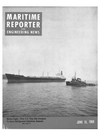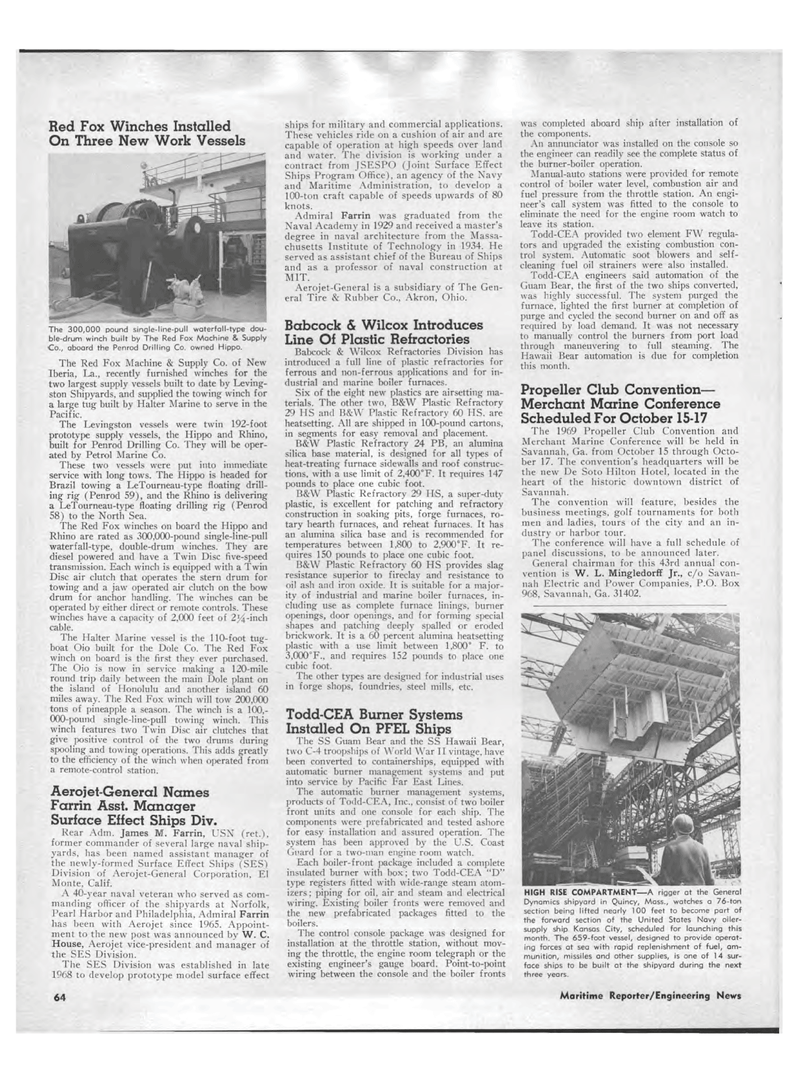
Page 62: of Maritime Reporter Magazine (June 15, 1969)
Read this page in Pdf, Flash or Html5 edition of June 15, 1969 Maritime Reporter Magazine
Red Fox Winches Installed On Three New Work Vessels The 300,000 pound single-line-pull waterfall-type dou-ble-drum winch built by The Red Fox Machine & Supply Co., aboard the Penrod Drilling Co. owned Hippo. The Red Fox Machine & Supply Co. of New Iberia, La., recently furnished winches for the two largest supply vessels built to date by Leving-ston Shipyards, and supplied the towing winch for a large tug built by Halter Marine to serve in the Pacific. The Levingston vessels were twin 192-foot prototype supply vessels, the Hippo and Rhino, built for Penrod Drilling Co. They will be oper-ated by Petrol Marine Co. These two vessels were put into immediate service with long tows. The Hippo is headed for Brazil towing a LeTourneau-type floating drill-ing rig (Penrod 59), and the Rhino is delivering a LeTourneau-type floating drilling rig (Penrod 58) to the North Sea. The Red Fox winches on board the Hippo and Rhino are rated as 300,000-pound single-line-pull waterfall-type, double-drum winches. They are diesel powered and have a Twin Disc five-speed transmission. Each winch is equipped with a Twin Disc air clutch that operates the stern drum for towing and a jaw operated air clutch on the bow drum for anchor handling. The winches can be operated by either direct or remote controls. These winches have a capacity of 2,000 feet of 2*4-inch cable. The Halter Marine vessel is the 110-foot tug-boat Oio built for the Dole Co. The Red Fox winch on board is the first they ever purchased. The Oio is now in service making a 120-mile round trip daily between the main Dole plant on the island of Honolulu and another island 60 miles away. The Red Fox winch will tow 200,000 tons of pineapple a season. The winch is a 100,-000-pound single-line-pull towing winch. This winch features two Twin Disc air clutches that give positive control of the two drums during spooling and towing operations. This adds greatly to the efficiency of the winch when operated from a remote-control station. Aerojet-General Names Farrin Asst. Manager Surface Effect Ships Div. Rear Adm. James M. Farrin, USN (ret.), former commander of several large naval ship-yards, has been named assistant manager of the newly-formed Surface Effect Ships (SES) Division of Aerojet-General Corporation. El Monte, Calif. A 40-year naval veteran who served as com-manding officer of the shipyards at Norfolk, Pearl Harbor and Philadelphia, Admiral Farrin has been with Aerojet since 1965. Appoint-ment to the new post was announced by W. C. House, Aerojet vice-president and manager of the SES Division. The SES Division was established in late 1968 to develop prototype model surface effect ships for military and commercial applications. These vehicles ride on a cushion of air and are capable of operation at high speeds over land and water. The division is working under a contract from JSESPO (Joint Surface Effect Ships Program Office), an agency of the Navy and Maritime Administration, to develop a 100-ton craft capable of speeds upwards of 80 knots. Admiral Farrin was graduated from the Naval Academy in 1929 and received a master's degree in naval architecture from the Massa-chusetts Institute of Technology in 1934. He served as assistant chief of the Bureau of Ships and as a professor of naval construction at MIT. Aerojet-General is a subsidiary of The Gen-eral Tire & Rubber Co., Akron, Ohio. Babcock & Wilcox Introduces Line Of Plastic Refractories Babcock & Wilcox Refractories Division has introduced a full line of plastic refractories for ferrous and non-ferrous applications and for in-dustrial and marine boiler furnaces. Six of the eight new plastics are airsetting ma-terials. The other two, B&W Plastic Refractory 29 HS and B&W Plastic Refractory 60 HS. are heatsetting. All are shipped in 100-pound cartons, in segments for easy removal and placement. B&W Plastic Refractory 24 PB, an alumina silica base material, is designed for all types of heat-treating furnace sidewalls and roof construc-tions, with a use limit of 2,400°F. It requires 147 pounds to place one cubic foot. B&W Plastic Refractory 29 HS, a super-duty plastic, is excellent for patching and refractory construction in soaking pits, forge furnaces, ro-tary hearth furnaces, and reheat furnaces. It has an alumina silica base and is recommended for temperatures between 1,800 to 2,900°F. It re-quires 150 pounds to place one cubic foot. B&W Plastic Refractory 60 HS provides slag resistance superior to fireclay and resistance to oil ash and iron oxide. It is suitable for a major-ity of industrial and marine boiler furnaces, in-cluding use as complete furnace linings, burner openings, door openings, and for forming special shapes and patching deeply spalled or eroded brickwork. It is a 60 percent alumina heatsetting plastic with a use limit between 1.800° F. to 3,000°F., and requires 152 pounds to place one cubic foot. The other types are designed for industrial uses in forge shops, foundries, steel mills, etc. Todd-CEA Burner Systems Installed On PFEL Ships The SS Guam Bear and the SS Hawaii Bear, two C-4 troopships of World War 11 vintage, have been converted to containerships, equipped with automatic burner management systems and put into service by Pacific Far East Lines. The automatic burner management systems, products of Todd-CEA, Inc., consist of two boiler front units and one console for each ship. The components were prefabricated and tested ashore for easy installation and assured operation. The system has been approved by the U.S. Coast Guard for a two-man engine room watch. Each boiler-front package included a complete insulated burner with box; two Todd-CEA "D" type registers fitted with wide-range steam atom-izers; piping for oil. air and steam and electrical wiring. Existing boiler fronts were removed and the new prefabricated packages fitted to the boilers. The control console package was designed for installation at the throttle station, without mov-ing the throttle, the engine room telegraph or the existing engineer's gauge board. Point-to-point wiring between the console and the boiler fronts was completed aboard ship after installation of the components. An annunciator was installed on the console so the engineer can readily see the complete status of the burner-boiler operation. Manual-auto stations were provided for remote control of boiler water level, combustion air and fuel pressure from the throttle station. An engi-neer's call system was fitted to the console to eliminate the need for the engine room watch to leave its station. Todd-CEA provided two element FW regula-tors and upgraded the existing combustion con-trol system. Automatic soot blowers and self-cleaning fuel oil strainers were also installed. Todd-CEA engineers said automation of the Guam Bear, the first of the two ships converted, was highly successful. The system purged the furnace, lighted the first burner at completion of purge and cycled the second burner on and off as required by load demand. It was not necessary to manually control the burners from port load through maneuvering to full steaming. The Hawaii Bear automation is due for completion this month. Propeller Club Convention? Merchant Marine Conference Scheduled For October 15-17 The 1969 Propeller Club Convention and Merchant Marine Conference will be held in Savannah, Ga. from October 15 through Octo-ber 17. The convention's headquarters will be the new De Soto Hilton Hotel, located in the heart of the historic downtown district of Savannah. The convention will feature, besides the business meetings, golf tournaments for both men and ladies, tours of the city and an in-dustry or harbor tour. The conference will have a full schedule of panel discussions, to be announced later. General chairman for this 43rd annual con-vention is W. L. Mingledorff Jr., c/o Savan-nah Electric and Power Companies, P.O. Box 968, Savannah, Ga. 31402. HIGH RISE COMPARTMENT?A rigger at the General Dynamics shipyard in Quincy, Mass., watches a 76-ton section being lifted nearly 100 feet to become part of the forward section of the United States Navy oiler-supply ship Kansas City, scheduled for launching this month. The 659-foot vessel, designed to provide operat-ing forces at sea with rapid replenishment of fuel, am-munition, missiles and other supplies, is one of 14 sur-face ships to be built at the shipyard during the next three years. 64 Maritime Reporter/Engineering News

 61
61

 63
63
